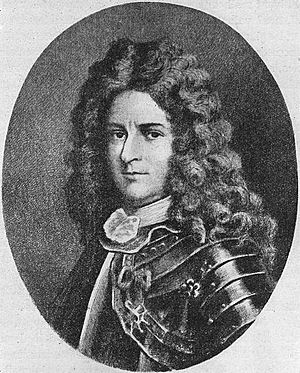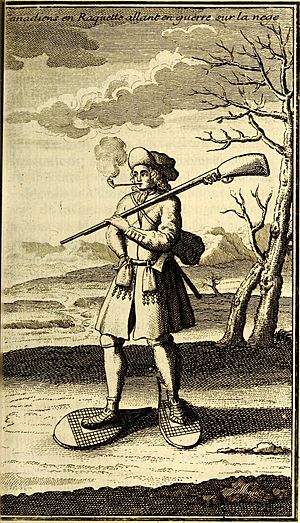Schenectady massacre facts for kids
The Schenectady massacre was a surprise attack on the village of Schenectady. This village was part of the New York colony. On February 8, 1690, a group of over 200 Frenchmen and their Mohawk and Algonquin allies attacked.
The village was not guarded. The attackers destroyed most homes. They killed or captured many people living there. Sixty residents died, including 11 enslaved Africans. About 60 people survived the attack. This included 20 Mohawk people.
Of the non-Mohawk survivors, 27 were taken captive. Five of these captives were African people. Some captives were later set free. Two men returned to Schenectady after living with the Mohawk for years. Other captives were likely adopted by Mohawk families in Canada.
This French attack was revenge for the Lachine massacre. That was an attack by Iroquois forces on a French village. These fights were part of the Beaver Wars. They were also part of the struggle between France and England. Both countries wanted control of the fur trade in North America. This was also during King William's War between France and England. The French wanted to weaken English power. They also hoped to separate the Iroquois from their English allies.
Why the Attack Happened
In the late 1600s, the Iroquois and colonists from New France were often at war. This long fight was called the Beaver Wars. They were fighting for control of the important fur trade in North America. The Iroquois also fought other Native American groups for this valuable trade.
In August 1689, the Iroquois launched a major attack. They raided Lachine, a French frontier town. This happened after France and England had started a war in Europe. News of this war had not yet reached North America.
The governor of New France, Comte de Frontenac, planned a counter-attack. He organized a group from Montreal to strike English outposts. This was to get back at the English for supporting the Iroquois. It was also to expand the war against the English colonies. He hoped to scare the Iroquois. He also wanted to cut off their trade with the English.
This expedition was one of three planned attacks. It was first aimed at Fort Orange, which is now Albany. The group included 114 French Canadians. Most were skilled coureurs de bois (forest runners). There were also some French soldiers. About 80 Sault and 16 Algonquin warriors joined them. A few converted Mohawks were also part of the group. They marched about 200 miles in 22 days. Taking Fort Orange would have been a big blow to the English.
Near what is now Fort Edward, the French officers met. They decided on their attack plan. The leaders were Jacques Le Moyne de Sainte-Hélène and Nicolas d'Ailleboust de Manthet. Pierre Le Moyne d'Iberville, who later founded Louisiana, was second-in-command.
The group traveled across the frozen Lake Champlain and Lake George. They moved towards English towns on the Hudson River. They found Fort Orange was well protected. But a scouting team reported something important on February 8. No one was guarding the stockade at Schenectady. Schenectady was a small frontier village to the west. Most of its residents were Dutch Americans. Many African enslaved people lived there too.
Schenectady and Albany had political problems. This was after Leisler's Rebellion in 1689. The different groups could not agree on setting up guards. This left both communities vulnerable. The village of Schenectady got its name from a Mohawk word. It meant "beyond the Pines." It was about seven miles past the western edge of Rensselaerswyck.
The Attack on Schenectady
The attackers found no guards, only two snowmen. The gate was also open. According to stories, the raiders quietly entered Schenectady. This was two hours before dawn. They then launched their attack. They burned houses and barns. They killed men, women, and children. Most victims were in their nightclothes. They had no time to get weapons.
By the morning of February 9, the village was in ruins. More than 60 buildings were burned. Sixty residents were killed. This included 11 African enslaved people. The French noted that about 50-60 residents survived. They spared 20 Mohawks. This was so the Native allies would know the target was the English, not the Mohawks.
The 60 people who died included 38 men, 10 women, and 12 children. Among them was Dominie Petrus Tessemacher. He was the first Dutch Reformed Church pastor ordained in the New World. The French wanted to capture him for questioning. But he was killed in his home. Reynier Schaets and his son also died. Schaets was a surgeon. He had been appointed Justice at Schenectady. His wife and three other children survived.
Many people tried to escape the burning village. They sought shelter with families miles away. But many died from the bitter cold before reaching safety. The raiders left with 27 prisoners. This included five African people. They also took 50 horses.
John Alexander Glen lived in Scotia, across the river. He had been kind to the French before. Because of this, the raiding party took the Schenectady prisoners to him. They invited him to claim any relatives. Glen claimed as many survivors as he could. The raiders took the rest to Montreal. Captives who were too young, old, or sick often died on the hard 200-mile journey. Many younger captives were adopted by Mohawk families in Canada. This was common in raids in New York and New England.
Some survivors fled to the fort at Albany. Symon Schermerhorn was one of them. Even though he was wounded, he rode to Albany. He warned them of the massacre. To remember this, the mayor of Schenectady repeats the ride every year. Most mayors do it on horseback.
A group of Albany militia and Mohawk warriors chased the invaders. They killed or captured 15 or more. This happened almost within sight of Montreal. Of the surviving captives, three males were set free. These were Johannes Teller and brothers Albert and Johannes Vedder. Jan Baptist Van Eps escaped after three years with the Mohawk. He returned to Schenectady. Lawrence Vander Volgen lived with the Mohawk for 11 years. He then returned and became a provincial interpreter.
What Happened Next
The attack forced New York's political groups to work together. They had to focus on their common enemy, New France. Because of the attack, the Albany Convention accepted Jacob Leisler's authority. Leisler had taken power in the southern parts of the colony.
With help from Connecticut officials, Leisler planned a counter-attack. The next summer, he organized an expedition from Albany to attack Montreal. General Fitz-John Winthrop led the Connecticut militia. But the expedition turned back in August 1690. This was due to disease, lack of supplies, and not enough boats for Lake Champlain.
Remembering the Event
In 1990, the city of Schenectady asked composer Maria Riccio Bryce to create a musical work. This was to remember the 300th anniversary of the massacre. The piece was called Hearts of Fire. It showed the lives of Schenectady townspeople in 1689. It also showed the French march from Montreal to Albany. Even though the settlers lost many lives and captives, they chose to stay. They rebuilt their town, honoring their relatives' memory.



